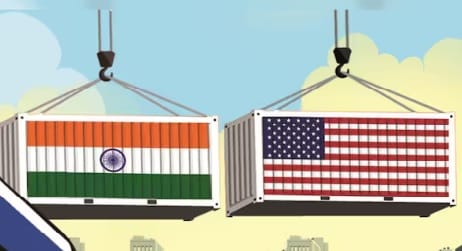By Bibhudatta Pradhan / NEW DELHI
U.S. President Donald Trump has imposed a 27% tariff on imports from India as part of his global reciprocal tax policy, escalating trade tensions and rattling the global economy.
The tariff begins with a 10% baseline rate effective this Saturday, with the remaining, higher reciprocal tariff kicking in on April 9.
Trump’s tariff offensive appears to spare his “great friend,” Indian Prime Minister Narendra Modi, from the harshest measures. India faces a 27% tariff—significantly lower than the 34% imposed on China and 46% on Vietnam, though higher than the 24% on Japan and 20% on the European Union.
“The Prime Minister just left. He’s a great friend of mine, but I said, ‘You’re a friend of mine, but you’re not treating us right,’’ Trump remarked at the White House while announcing his reciprocal tax policy. `They charge us 52%. You have to understand, we charge them almost nothing for years and years and decades.’’ Trump framed these new measures as “discounted’’ reciprocal tariffs, aimed at leveling the playing field.
India has some of the world’s highest tariffs. Trump has repeatedly called India the “tariff king,” labeling its policies as “brutal.” According to a White House statement, the U.S. imposes a modest 2.5% tariff on passenger vehicle imports, while India levies a steep 70% on the same category. Similarly, apples enter the U.S. duty-free, yet India imposes a 50% duty on U.S. apples entering its market.
As of 2024, the U.S. is India’s largest trading partner, though India ranks tenth among U.S. trading partners. Bilateral trade between the world’s most populous nation and the U.S. reached $129 billion in 2024. India exported $87 billion worth of goods to the U.S., while importing $41.8 billion, resulting in a trade surplus of $45.7 billion in India’s favor.
The U.S. lists pearls, semi-precious stones, pharmaceutical products, and electrical equipment among its top imports from India. India, in turn, imports crude oil and related products, gems and stones, nuclear reactors, and electrical and medical equipment from the U.S.
The new tariff policy is expected to affect several key sectors of the Indian economy, including IT, pharmaceuticals, automobiles, agriculture, and textiles, given the importance of the U.S. as a trading partner. The full impact of the new tariffs on India will become clear later, depending on sector-specific analysis and India’s ability to leverage lower U.S. tariffs compared to regional competitors.
India’s exports to the U.S. could decline by $30–33 billion under the new tariffs, estimates Madhavi Arora, chief economist at Emkay Global Financial Services. This drop would represent a 0.9% reduction in India’s gross domestic product, excluding the effects of any countermeasures or retaliatory actions.
India is currently examining the implications of the new policy, the Ministry of Commerce and Industry, said in a statement. “The Department is also studying the opportunities that may arise due to this new development in the US trade policy,’’ it added.
While the new U.S. tariffs pose certain challenges for India, they could also present new avenues for collaboration. The timing aligns with ongoing negotiations for a bilateral trade agreement between the two countries, which is expected to be finalized by the fall of 2025. The deal could open greater access to India’s markets for U.S. exports—ranging from energy and electric vehicles to, potentially, agricultural products—thereby strengthening trade ties.
India may also accelerate trade negotiations with other partners, including the UK and the European Union, as it seeks to diversify its trade relationships and offset the impact of the new tariffs.
High tariffs on Chinese and Bangladeshi exports open up space for Indian textile manufacturers to expand their presence in the U.S. market. While Taiwan remains a leader in semiconductor production, India could carve a niche in chip packaging, testing, and lower-end manufacturing—provided it strengthens its infrastructure and policy support.
Trump’s decision to impose higher reciprocal tariffs on several countries such as China, Vietnam, Taiwan, Thailand, and Bangladesh, could give India a chance to strengthen its position in global trade and manufacturing, said Ajay Srivastava of the Global Trade Research Initiative, according to The Economic Times.
India may now enjoy a certain comparative advantage in accessing the U.S. market, particularly over key competitors such as Vietnam, Bangladesh, and China.
“Looking at the tariffs, I don’t think we’re as adversely affected. The 26% tariff may seem high, but in comparison with rates imposed on other Southeast Asian nations, India fares better,” said Sanjay Nayar, President of ASSOCHAM. “We’re likely to witness a significant realignment of intra-Asia trade and supply chains. India must now consider how to offer the U.S. greater access to its own market in return.’’

